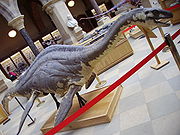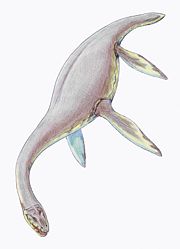
Cryptoclidus
Encyclopedia
Cryptoclidus was a genus
of plesiosaur
(a type of marine reptile
) from the Middle Jurassic
period of England
.
 Cryptoclidus is a plesiosaur
Cryptoclidus is a plesiosaur
whose specimens include adult and juvenile skeletons, and remains which have been found in various degrees of preservation in England, Northern France, Russia, and South America. Its name, meaning "hidden clavicles", refer to its small, practically invisible clavicle
s buried in its front limb girdle.
The type species was initially described as Plesiosaurus
eurymerus by Phillips (1871). The species name "wide femur" refers to the forelimb, which was mistaken for a hindlimb at the time.
 Cryptoclidus is estimated to have weighed about 8 tons. Its head was rather flattened, with eyes facing upward. The skull was broad and light, with jaws lined with about a hundred long, fine teeth, ideal for catching fish and squid. The internal nares were set forward, and the nostrils were relatively small. At up to 8 metres (26.2 ft) long, Cryptoclidus was a medium-sized plesiosaur.
Cryptoclidus is estimated to have weighed about 8 tons. Its head was rather flattened, with eyes facing upward. The skull was broad and light, with jaws lined with about a hundred long, fine teeth, ideal for catching fish and squid. The internal nares were set forward, and the nostrils were relatively small. At up to 8 metres (26.2 ft) long, Cryptoclidus was a medium-sized plesiosaur.
 It had a neck that was up to 2 metres (6.6 ft) long that does not seem to have been very flexible. This probably kept its bulky body away from its small head so as not to alarm potential prey. It had four broad paddle-shaped limbs, with which it either "flew" through the water in wave-like undulating movements, or swam like a porpoise by moving upwards on two flippers and gliding back down again on the other two.
It had a neck that was up to 2 metres (6.6 ft) long that does not seem to have been very flexible. This probably kept its bulky body away from its small head so as not to alarm potential prey. It had four broad paddle-shaped limbs, with which it either "flew" through the water in wave-like undulating movements, or swam like a porpoise by moving upwards on two flippers and gliding back down again on the other two.
-like body plan, small plesiosaurs such as Cryptoclidus have been depicted as amphibious animals instead of fully marine reptiles. Despite looking clumsy and cumbersome, in water it would have been relatively graceful, using all four limbs as paddles, to swim and hunt its prey. It may have laid eggs in sand, but this is conjectural.
The fragile build of the head and teeth preclude any grappling with prey, and suggest a diet of small, soft-bodied animals such as squid
and shoaling fish. Cryptoclidus may have used its long, intermeshing teeth to strain small prey from the water, or perhaps sift through sediment for buried animals.
The size and shape of the nares and nasal openings have led Brown and Cruickshank (1994) to argue that they were used to sample seawater for smells and chemical traces.
Genus
In biology, a genus is a low-level taxonomic rank used in the biological classification of living and fossil organisms, which is an example of definition by genus and differentia...
of plesiosaur
Plesiosaur
Plesiosauroidea is an extinct clade of carnivorous plesiosaur marine reptiles. Plesiosauroids, are known from the Jurassic and Cretaceous Periods...
(a type of marine reptile
Reptile
Reptiles are members of a class of air-breathing, ectothermic vertebrates which are characterized by laying shelled eggs , and having skin covered in scales and/or scutes. They are tetrapods, either having four limbs or being descended from four-limbed ancestors...
) from the Middle Jurassic
Jurassic
The Jurassic is a geologic period and system that extends from about Mya to Mya, that is, from the end of the Triassic to the beginning of the Cretaceous. The Jurassic constitutes the middle period of the Mesozoic era, also known as the age of reptiles. The start of the period is marked by...
period of England
England
England is a country that is part of the United Kingdom. It shares land borders with Scotland to the north and Wales to the west; the Irish Sea is to the north west, the Celtic Sea to the south west, with the North Sea to the east and the English Channel to the south separating it from continental...
.
Discovery

Plesiosaur
Plesiosauroidea is an extinct clade of carnivorous plesiosaur marine reptiles. Plesiosauroids, are known from the Jurassic and Cretaceous Periods...
whose specimens include adult and juvenile skeletons, and remains which have been found in various degrees of preservation in England, Northern France, Russia, and South America. Its name, meaning "hidden clavicles", refer to its small, practically invisible clavicle
Clavicle
In human anatomy, the clavicle or collar bone is a long bone of short length that serves as a strut between the scapula and the sternum. It is the only long bone in body that lies horizontally...
s buried in its front limb girdle.
The type species was initially described as Plesiosaurus
Plesiosaurus
Plesiosaurus was a genus of large marine sauropterygian reptile that lived during the early part of the Jurassic Period, and is known by nearly complete skeletons from the Lias of England...
eurymerus by Phillips (1871). The species name "wide femur" refers to the forelimb, which was mistaken for a hindlimb at the time.
Appearance


Lifestyle and feeding
Due to their sealPinniped
Pinnipeds or fin-footed mammals are a widely distributed and diverse group of semiaquatic marine mammals comprising the families Odobenidae , Otariidae , and Phocidae .-Overview: Pinnipeds are typically sleek-bodied and barrel-shaped...
-like body plan, small plesiosaurs such as Cryptoclidus have been depicted as amphibious animals instead of fully marine reptiles. Despite looking clumsy and cumbersome, in water it would have been relatively graceful, using all four limbs as paddles, to swim and hunt its prey. It may have laid eggs in sand, but this is conjectural.
The fragile build of the head and teeth preclude any grappling with prey, and suggest a diet of small, soft-bodied animals such as squid
Squid
Squid are cephalopods of the order Teuthida, which comprises around 300 species. Like all other cephalopods, squid have a distinct head, bilateral symmetry, a mantle, and arms. Squid, like cuttlefish, have eight arms arranged in pairs and two, usually longer, tentacles...
and shoaling fish. Cryptoclidus may have used its long, intermeshing teeth to strain small prey from the water, or perhaps sift through sediment for buried animals.
The size and shape of the nares and nasal openings have led Brown and Cruickshank (1994) to argue that they were used to sample seawater for smells and chemical traces.
External links
- http://www.palaeos.com/Vertebrates/Units/220Lepidosauromorpha/220.800.html Paleos Vertebrates - Cryptocleidoidea
- http://www.dinosauria.com/dml/names/ples.html Plesiosaur names and Pronunciation guide
Further reading
- Haines, Tim & Chambers, Paul. (2006) The Complete Guide to Prehistoric LifeThe Complete Guide to Prehistoric LifeThe Complete Guide to Prehistoric Life is an encyclopedia featuring 111 of the prehistoric animals from the Walking With... series, as well as an additional one . It was published in 2006 by Firefly Books, and written by Tim Haines with Paul Chambers...
. Canada: Firefly Books Ltd.

